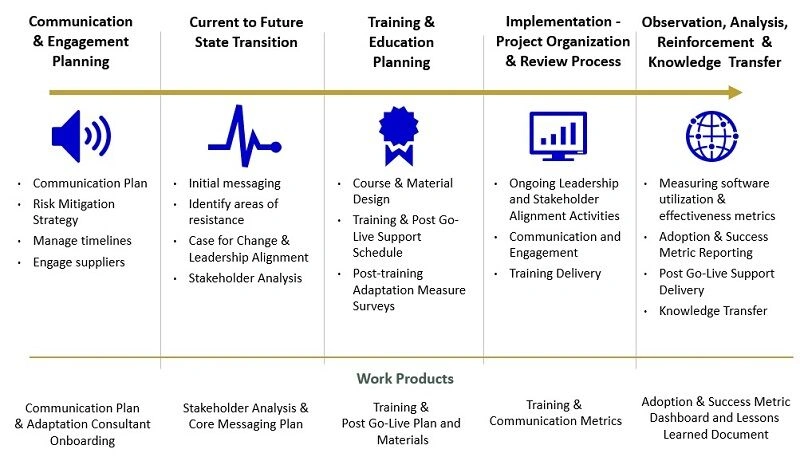How to Implement Change Management: 5 Steps to Success

- Last Updated: Nov 13, 2025
- 15 min read
- Sirion
In the US Presidential election of 1992, James Carville popularized the phrase “It’s the economy, stupid.” And in the case of change management, we can very well say;
“It’s the people, stupid”
Change management is not a new term. For over three decades, organizations have realized that the people side of a transformational effort—especially in enterprise software rollouts—poses the biggest challenge. This is particularly true in complex, cross-functional systems like contract lifecycle management (CLM), where legal, procurement, and business teams must all adopt new processes and tools.
At Sirion, we’ve seen firsthand that implementing change management during CLM system deployments can make the difference between missed adoption goals and measurable ROI.
We understand that managing change is tough, but part of the problem is that there is little agreement on the underlying factors influencing transformation initiatives the most.
Ask ten managers to name the key factors critical to the success of these programs, and you’ll probably get ten different answers. That’s because each executive looks at an initiative from his or her viewpoint and, based on personal experience, focuses on different success factors. The experts, too, offer different perspectives.
Before diving into our approach, let’s clarify what change management really means in an enterprise context.
What Is Change Management?
Change management refers to a structured approach that helps individuals, teams, and organizations transition from a current state to a desired future state. It includes the methods and processes used to manage the people side of change to achieve business outcomes and minimize resistance.
In enterprise implementations—such as deploying new technology or restructuring operations—change management ensures that employees not only adopt the new systems but also adapt their behaviors and workflows to match. Effective change management balances leadership alignment, stakeholder engagement, communication, training, and performance measurement.
While the value of change management is clear, implementing it isn’t always straightforward. Let’s look at the most common pitfalls that derail transformation initiatives.
Common Challenges in Implementing Change Management
Despite the best intentions, many change initiatives fall short due to recurring obstacles, including:
- Resistance to change: Employees may feel uncertain or threatened by new systems and processes.
- Lack of leadership buy-in: Without visible and consistent support from top leadership, change efforts lose momentum.
- Poor communication: Vague or inconsistent messaging creates confusion and undermines trust.
- Inadequate training: Users struggle to adapt when they don’t understand how the change impacts their role or how to navigate the new environment.
- No clear metrics: Success is hard to track if there’s no structured way to measure adaptation, proficiency, and utilization.
Recognizing these challenges upfront enables organizations to take a more structured, proactive approach—which brings us to how we do it at Sirion.
At Sirion, over the years, we have learned that any significant software implementation project (such as contract management automation) requires deliberate change and adaptation management. Our philosophy is to formalize the “soft” side of an implementation and not assume that people will get there by themselves. The focus is to measure people’s adaptation of the new environment early on and throughout the initiative and to develop a fact-based perspective on the level of adaptation to the new environment. This proactive approach vs. the generally reactive approach towards people management has significant benefits:
- Faster return on investment
- Reduction in internal turmoil and early identification of resistance to change
- Fact-based analysis and measurement of software adaptation, reducing reliance on subjective perceptions.
With these risks in mind, what can organizations gain from implementing change management effectively?
Benefits of Implementing Change Management Effectively
Organizations that invest in structured change management processes see measurable improvements across key performance areas:
- Faster user adoption: Clear communication, training, and engagement help teams adapt more quickly.
- Higher return on investment: Better adoption means new tools or processes deliver value sooner.
- Reduced resistance and disruption: Proactive engagement prevents roadblocks before they emerge.
- Improved productivity: Employees gain confidence in using new systems, leading to fewer errors and higher efficiency.
- Sustainable change: Ongoing reinforcement and measurement ensure the change sticks over time.
These benefits highlight why we focus so intently on formalizing the “soft” side of implementation.
Five elements of success in change management
Our experience shows that companies must pay as much attention to the soft side of implementation as they do to the actual implementation. By focusing on the following five critical elements, they can stack the odds in favor of success.
- Capability – Understanding client needs and their internal capabilities to absorb new technologies. This will define the level of training needed.
- Execution – An integrated project plan that accounts for a 360-degree view of technical implementation and change management is imperative. The project organization is governed by necessary oversight structure including the executive steering committee, management committee, and the implementation team make-up. If suppliers or customers are part of the implementation, their participation should carefully be considered.
- Software adaptation by the organization – Referred, sometimes, as change management or the people side of implementation, this aspect is frequently overlooked even though it is a significant contributor to the success or failure of a project. The key is to assist and measure the organization in transitioning from general awareness to commitment to using the software.
- User Proficiency (in the new environment) – Assessment of the training and ongoing support effectiveness to ensure user adaptation and proficiency.
- Utilization – Assessment of the frequency and duration of software usage post-implementation.
Sirion’s 5-Step Approach to Change and Adaptation Management
Sirion follows a broad-based methodology to support adaptation management during enterprise software implementations. This approach ensures stakeholders move from awareness to buy-in, and ultimately, to active adoption, outlined in Fig 1below:

1. Communications and Engagement Planning
The first step is to develop a communication and engagement plan with a defined calendar for stakeholder touchpoints. The primary goal is to get everyone aligned and establish channels to address concerns proactively.
Key actions include:
- Creating messaging and an executive letter for internal stakeholders
- Drafting a detailed internal announcement for impacted teams
- Opening dedicated communication lines for external stakeholders
- Explaining the rationale for change and benefits to clients or suppliers
- Maintaining consistent monthly communication through implementation and go-live
2. Current-to-Future State Transition
Ahead of implementation, it’s important to ensure that the intended change is clearly understood and backed by a strong business case.
At this stage:
- Begin introducing the future state to internal and external stakeholders
- Align introductory materials with your adaptation and training approach
- Conduct stakeholder meetings to identify potential resistance
- Integrate future-state messaging into training materials for consistency and reinforcement
3. Training and Education Planning
This step ensures that stakeholders are not only trained on the new system, but also understand its relevance and benefits.
Activities include:
- Adaptation consultants guiding and supporting individuals or areas showing resistance
- Training materials reinforcing the “why” behind the project
- Administering adaptation measurement tests at the end of training sessions to assess readiness
4. Implementation: Project Organization and Review
During implementation, maintaining structured oversight is key to ensuring alignment across all stakeholders.
Focus areas:
- Forming an executive steering committee representing stakeholder interests
- Reinforcing leadership alignment throughout each phase of the rollout
- Maintaining timely, consistent communication from leadership to impacted teams
- Avoiding disengagement during the later phases of implementation
5. Observation, Analysis, Reinforcement, and Knowledge Transfer
Change management doesn’t stop at go-live. Continuous measurement and knowledge sharing are crucial for long-term adoption.
Ongoing actions:
- Measuring adaptation from kickoff through training and post go-live
- Regularly analyzing and sharing results with internal teams and external partners
- Reinforcing learnings through continued observation and support
- Comparing post-implementation software utilization metrics with adaptation levels to track progress
Getting Change Right in CLM Is a Strategic Advantage
Change is inevitable—but success is optional.
By investing in structured change management, companies can turn employee resistance into readiness, increase user adoption, and achieve faster time to value. At Sirion, we’ve seen firsthand that formalizing the soft side of implementation is often the hardest—but most rewarding—part of the journey.
FAQs on Implementing Change Management in Contract Management Systems
Why is change management critical when implementing a CLM system?
Implementing a contract lifecycle management (CLM) system change how legal, procurement, finance, and sales teams manage contracts. Without structured change management, there’s a high risk of resistance, underutilization of features, and delays in realizing value. Change management ensures stakeholder alignment, smooth adoption, and a faster return on investment.
What makes change management in CLM projects uniquely challenging?
CLM projects touch multiple departments, each with different goals. Legal may prioritize risk mitigation, procurement may focus on speed and cost control, and sales may care about deal velocity. Aligning these diverse perspectives requires thoughtful communication, clear training, and early identification of resistance to change.
Who should be part of the change leadership team during a CLM implementation?
A cross-functional team is essential. Ideally, this includes:
- An executive sponsor (typically from legal or operations)
- A CLM product owner or admin
- Legal operations or contract managers
- Procurement and finance reps
- A dedicated change management lead
This team ensures organizational readiness and consistent messaging across business functions.
What are some common signs that change management is failing during a CLM rollout?
Warning signs include:
- Users reverting to offline tools or legacy systems
- High support ticket volume post go-live
- Low login or utilization rates
- Complaints about unclear processes or lack of ownership
- Missed milestones due to resistance or confusion
These indicators point to the need for stronger engagement, training, or executive alignment.
How can success in change management for CLM be measured?
Look beyond go-live. Effective measurement includes:
- User adoption and login frequency
- Time to proficiency across departments
- Reduction in contract cycle times
- Utilization of advanced features (e.g., templates, playbooks, obligation tracking)
- Stakeholder feedback via surveys or check-ins
Additional Resources

Contract Management Software Implementation – How to Guide

